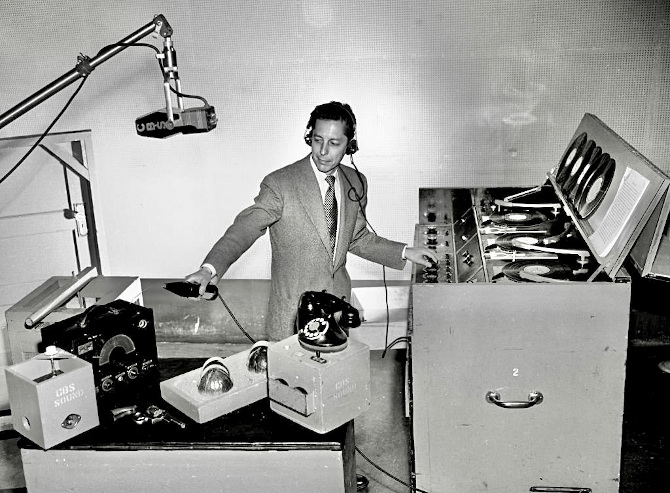How Two CBS Sound Technicians Created a Horde of Rats

When the script for CBS' Escape called for the sound of a horde of rats attacking a lighthouse, squealing, clawing at the windows, gnawing through a trap door and boarding a ship, it would seem almost enough to stump even a veteran radio soundperson. Escape's two veteran radio technicians, Bill Gould and Cliff Thorsness, admit that creating this effect was certainly about their toughest challenge. Their work on it deserves a Distinguished Achievement Award.
"It was a tough show to work out the sound on," the technicians acknowledged when we cornered them for a behind-the-scenes discussion, "because none of the effects called for were straight, legitimate ones. They couldn't be found in any sound library -- and CBS had the finest. We had sound recordings of individual rats, but none of them in quantity or doing the things this script called for them to be doing. So we had to start strictly from scratch."
Working under the supervision of Al Span, head of the CBS sound department, Thorsness and Gould set about manufacturing the realistic noises of a rat attack.
Three full days of preparation were required, including one day of special recording. To create the noise of rats in great quantity, the sound technicians combined recordings of mice, birds, pigs and monkeys, playing them back at diverse RPM speeds. They recorded for four solid hours, employing 10 turntables.
To create the sound of rats clawing at the windows, a big round stiff brush (off the janitor's giant sweeping broom) was hit upon as the most effective prop. The noise of the brush being swept across actual glass, amplified through a contact mic (the "throat mic" such as was used by Army pilots during the war) produced the desired effect.
For the sound of the rats gnawing through a wooden trap door, berry boxes were crunched, not as customarily in the hand, but in the technicians' mouths, because the actual noise made by the contact of wood against teeth made the difference between an unconvincing sound and a startlingly real one.
For the sound of the rats' teeth working on the metal parts of the trap door, tin cans were used and again a contact mic was employed.
The technicians reported that one of the most difficult effects to create for the show was the noise of the rats as they cling to the revolving beacon atop the lighthouse. For this, the volume of the rats' squealing was increased, then faded out, to produce the realism of their closeness as they were swung towards the hearer.
Another of the more difficult effects, according to the two technicians, came about when the script had one of the rats breaking away from the park, calling for the noise of a single rat to be heard effectively against the combined squealings and clawings of the horde.
The final difficult effect called for was the sound of the rodents vacating the lighthouse to scamper aboard a boat.
An additional reason the show was particularly challenging, the two sound effects people declared, was the fact that Escape's producer William N. Robson is a strong perfectionist. "An effect might sound very satisfactory," they clarified, "but with Robson, it had to sound really real."
"We were pleased," they admitted, "when Harry Bartell, one of the actors, told us we'd made the rats real enough to smell them."
Billy Gould laughed. "They became real enough to me -- I actually found myself not able to eat."
Escape's rats, however, weren't the first eerie effect which Gould and Thorsness have been called upon to produce.
"Remember," smiled Billy, ready to spoil his appetite again, "Arch Oboler's man-eating spider on Lights Out?"
"And," supplied Cliff, with a weak grin, "the attack of the ands on Escape's broadcast of Leiningen vs. the Ants!"
Thorsness also recalled working on the Norman Corwin production which starred sound entitled The Anatomy of Sound.
"That one wasn't easy," he remembered. "It was a narration built around all the ordinary sounds one hears throughout a day. It was a problem of producing simple sounds in a natural way yet making the listener very aware of them."
In addition to Escape, Thorsness works sound on other drama shows as Family Hour and Philip Marlowe, and has created effects in the past for Norman Corwin, Orson Welles, Man Called X, Big Town, Hollywood Star Time and Blondie.
Gould is soundperson on Escape, Johnny Dollar, the Joan Davis show and Our Miss Brooks, and previously worked Suspense, The Whistler, Fletcher Markel's Ford Theater, the Jack Kirkwood series, and the Jimmy Durante program.
Both Gould and Thorsness have been with the CBS sound department for more than 10 years.
Prior to this, Thorsness have manager of LA's downtown Orpheum Theater, and Gould was show-business veteran, having worked in vaudeville and tent shows since the age of seven.
Gould's goal is to produce and direct variety shows for television. Thorsness aspires to the production end of radio dramatic productions.
As a perfect tag for this story dealing with their creation of realistic radio rats, Thorsness made a confession.
"I can't stand mice. When it comes to taking a mouse out of a trap, I make my wife do it."
Lynn Roberts in Radio-TV Life, March 24, 1950
Add a Comment
All comments are moderated before publication. These HTML tags are permitted: <p>, <b>, <i>, <a>, and <blockquote>.
Top 10 Articles
- The Marriage of Don Ameche and Honore Prendergast
- The Night Arthur Godfrey Fired a Singer On Live Radio
- Early Radio Announcers Invented Their Profession in the 1920s
- The Mythical Town of East Tincup, Colorado
- The Earliest Radio Shows of the 1920s
- The Great Radio Detectives of the 1950s
- The Home Life of Jack Benny
- Why Vladimir Horowitz Stopped Performing in the 1930s
- Judy Canova: The Queen of Hillbilly Hokum
- Some of the Unsung Heroes of Radio

